Hazardous Waste Management Market Size
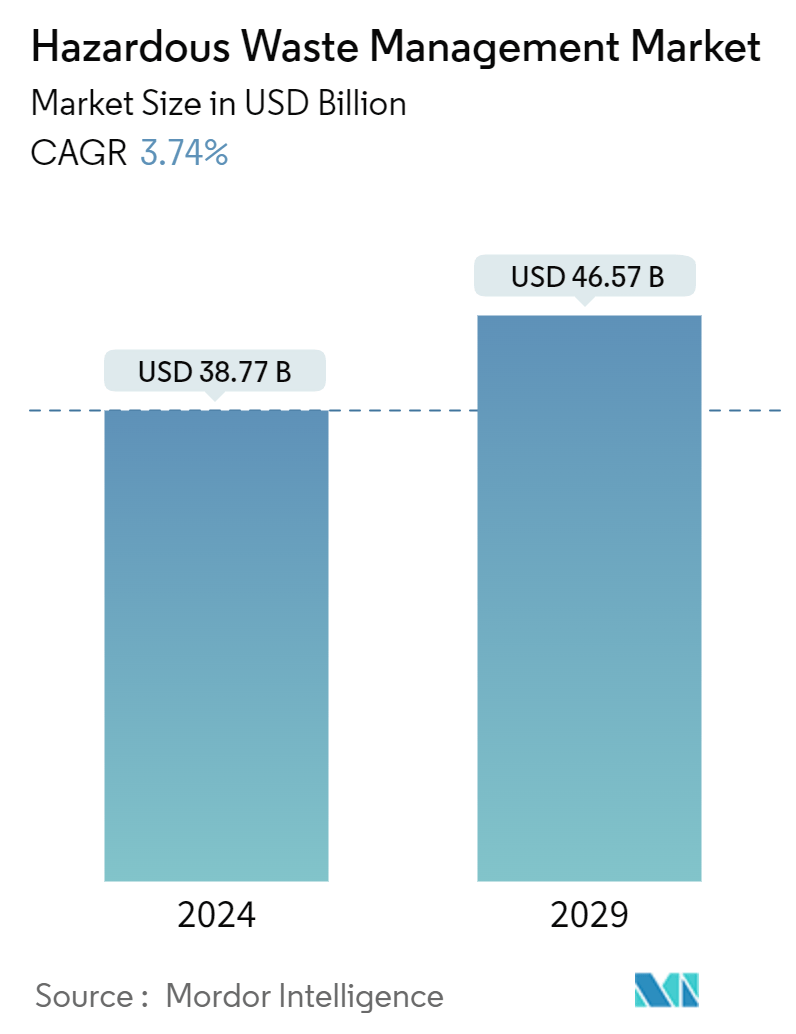
| Study Period | 2020 - 2029 |
| Market Size (2024) | USD 38.77 Billion |
| Market Size (2029) | USD 46.57 Billion |
| CAGR (2024 - 2029) | 3.74 % |
| Fastest Growing Market | North America |
| Largest Market | Asia Pacific |
Major Players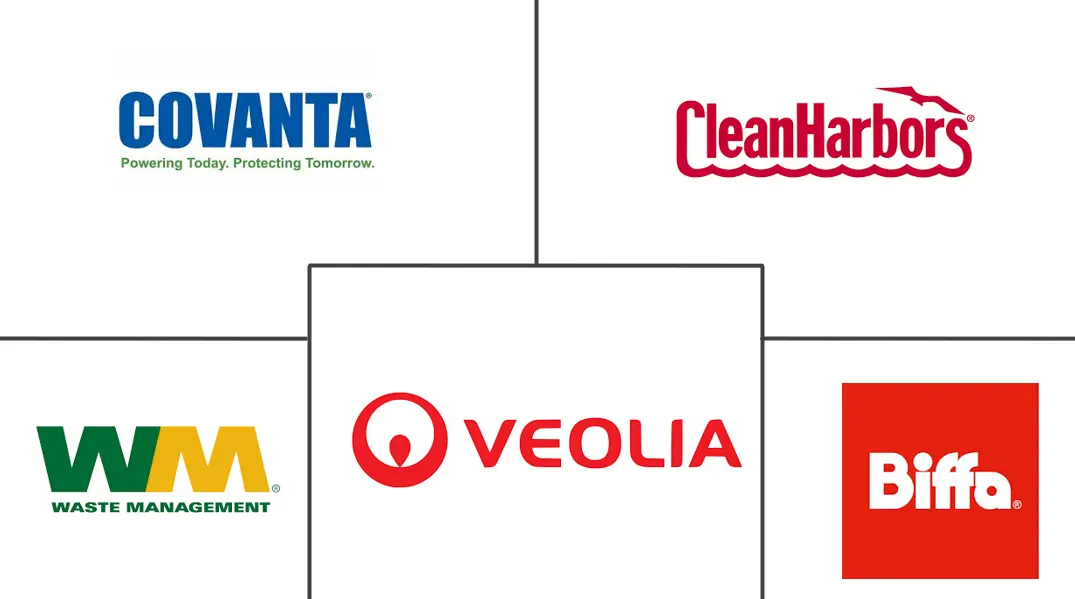
*Disclaimer: Major Players sorted in no particular order |
Hazardous Waste Management Market Analysis
The Hazardous Waste Management Market size is estimated at USD 38.77 billion in 2024, and is expected to reach USD 46.57 billion by 2029, growing at a CAGR of 3.74% during the forecast period (2024-2029).
- Hazardous waste management involves practices and procedures to handle, control, and dispose of substances that threaten human health or the environment. It includes waste collection, recycling, treatment, transportation, disposal, and monitoring of disposal sites. The primary objective is to mitigate risks and safeguard health and the environment.
- The hazardous waste management market is driven by several factors. Governments worldwide are intensifying their focus on waste disposal due to concerns over pollution and health risks. Consequently, stricter regulations are being enacted to govern waste disposal practices and encourage responsible management.
- Technological advancements have significantly bolstered hazardous waste management. Innovations in waste treatment and disposal have ushered in more efficient and eco-friendly methods. Notable technologies include steam autoclave treatment, chemical treatment, ozone treatment, pyrolysis, and electron beam technology. For instance, Pello is a new technology that has been developed to help businesses reduce their environmental impact and manage their waste collection more efficiently. Pello helps companies achieve these goals in a number of different ways. Firstly, the Pello system monitors the fill level of trash cans and provides real-time information on the dumpsters’ contents and location.
- In April 2023, Recycle Track Systems (RTS) acquired RecycleSmart Solutions, solidifying its position as Canada's premier independent provider of advanced waste diversion, organic capture, and recycling management technology. The acquisition encompassed Recycle Smart's cutting-edge Pello waste sensor technology, an integral part of its Internet of Things (IoT) platform.
Hazardous Waste Management Market Trends
Asia-Pacific Expected to Dominate the Market Over the Coming Years
- Rapid industrialization in countries like China, India, and Southeast Asian nations has driven a surge in hazardous waste production, notably in industries such as manufacturing, mining, and electronics. China, for instance, has witnessed a nearly threefold increase in waste output since the 1990s. This rise can be attributed to multiple factors. Over the past few decades, China's urbanization rate has steadily climbed. By 2023, data from the National Bureau of Statistics of China revealed that approximately 66.2% of the population was residing in urban areas.
- China's robust economic growth, evidenced by its 2023 GDP of roughly USD 17.7 trillion, as per the International Monetary Fund (IMF), further bolstered industrial waste production. While the volume of conventional industrial waste, such as tailings and fly ash, has remained stable, hazardous waste production has surged in tandem with industrial progress. Notably, these hazardous by-products necessitate more advanced treatment for safe disposal. A significant milestone was reached in March 2024 when Jereh Group introduced its GreenWell distributed hazardous waste treatment equipment. This innovative solution, tailored to address challenges in centralized hazardous waste disposal, allows for on-site treatment, bypassing the need for intermediary steps.
- By streamlining on-site treatment and eliminating intermediary steps, this state-of-the-art equipment significantly enhances processing efficiency, reduces waste, and facilitates wastewater recycling within the system. Impressively, it has already demonstrated its efficacy, cutting oily waste at well sites by over 20% and achieving an outstanding 95% recovery rate for basic oil. Furthermore, it enables zero-discharge recycling of wastewater within its operational framework.
- Over the past few decades, Asia-Pacific has made notable strides in enhancing its regulatory frameworks for managing hazardous waste. Governments have intensified environmental regulations, compelling industries to adopt more robust waste management practices. For instance, in 2021, the Central Government of India launched the Swachh Bharat Mission Urban 2.0 (SBM-U 2.0), envisioning "Garbage Free Cities." The mission targets all urban local bodies to secure at least a 3-star certification, emphasizing door-to-door collection, source segregation, and scientific processing of municipal solid waste.
- While rapid industrialization in Asia, particularly in China, has led to a notable uptick in hazardous waste generation, advancements in waste treatment technology and stringent regulatory frameworks are heralding a shift toward more efficient and eco-friendly waste management practices.
- The surge in hazardous waste production in rapidly industrializing countries like China and India underscores the critical need for advanced waste management solutions. China's significant economic growth and urbanization have directly contributed to increased hazardous waste, necessitating innovative treatment technologies like the GreenWell equipment. This technology not only improves processing efficiency but also supports environmental sustainability through wastewater recycling. Additionally, the strengthening of regulatory frameworks across the Asia-Pacific indicates a growing commitment to addressing environmental challenges, compelling industries to adopt better waste management practices. These developments suggest a positive trend toward more sustainable industrial growth in the region.
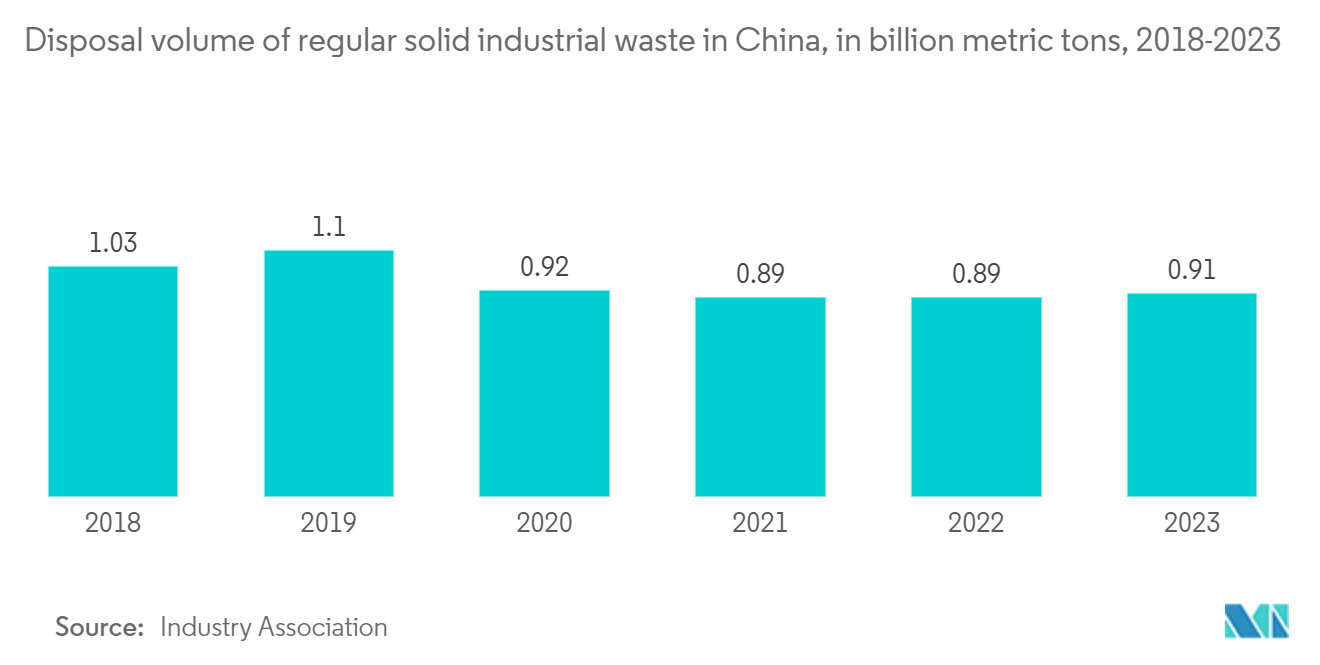
By Disposal Type, Collection Gaining More Traction Over the Coming Years
- Hazardous waste collection involves structured procedures to gather, manage, and transport materials that pose significant risks to human health and the environment. These materials are classified based on inherent traits (flammable, toxic, etc.) or specific designations by regulatory bodies. Accurate identification is crucial for applying proper handling and disposal protocols.
- In July 2024, Sedema, Mexico's Secretariat of the Environment, successfully transported over 5,600 tires from illegal dumps in Xochimilco and Gustavo Madero to a treatment plant. These tires will be repurposed as an alternative fuel in cement production. Partnering with Geocycle Mexico, this move is a cornerstone in Sedema's strategy to combat environmental challenges from improper tire disposal, which often leads to public pollution and heightened wildfire risks. Sedema announced plans to bolster its tire collection via the Reciclatrón Program, showcasing Mexico's commitment to holistic waste management and a shift away from fossil fuels and excessive mineral extraction.
- In June 2024, Ottawa's city council greenlit a Solid Waste Master Plan, responding to mounting pressures on the Trail Road Landfill, nearing its 2035 capacity. Concerns arise as replacing it could exceed USD 600 million. The endorsed strategy, spanning three decades, includes nearly 50 initiatives. These aim to divert waste, extending the landfill's life to 2049. Ottawa's approach highlights its dedication to sustainable waste management and long-term environmental stewardship.
- Effective hazardous waste collection demands strict regulatory compliance, proper personnel training, and collaboration among stakeholders, including waste generators, transporters, and disposal facilities. This collaboration ensures safe and compliant hazardous waste management.
- The hazardous waste collection market is evolving, driven by regulatory compliance and innovative waste management. Sedema's initiative in Mexico showcases a proactive stance on repurposing waste, reducing environmental risks, and promoting sustainability. Ottawa's Master Plan mirrors a commitment to waste reduction and resource management, addressing both immediate and future landfill concerns. These cases underscore a broader trend toward integrated waste management, prioritizing sustainability and public health.
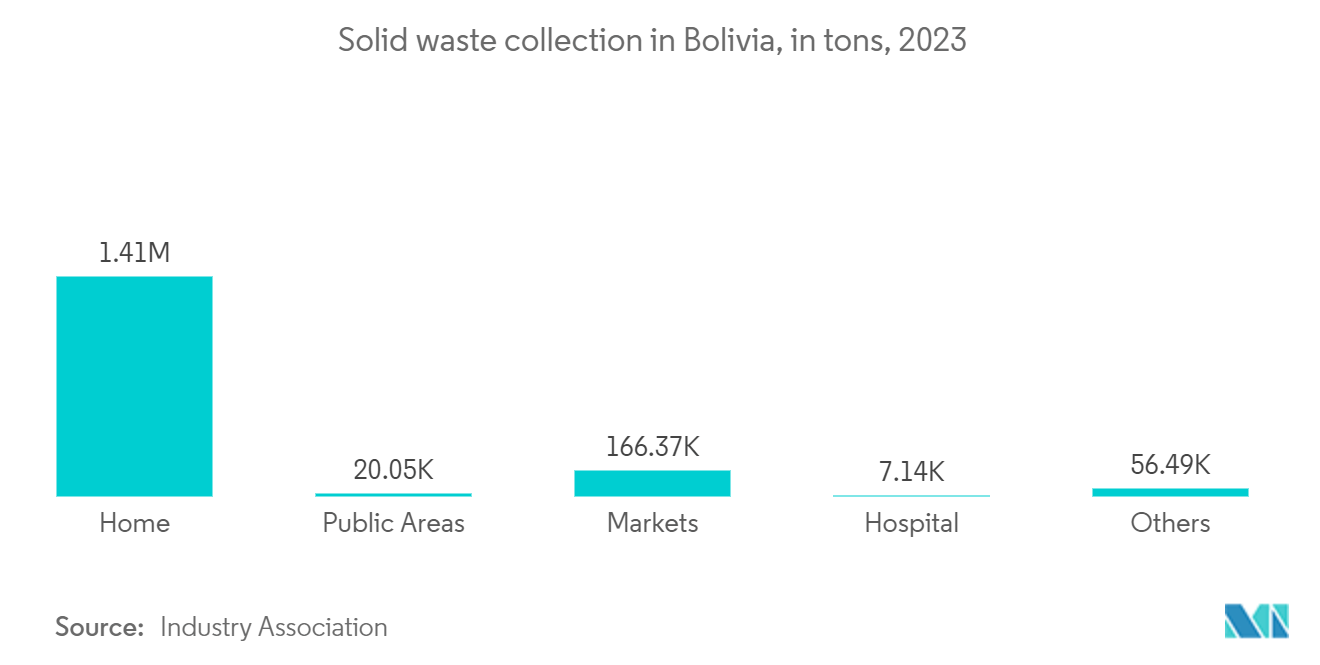
Hazardous Waste Management Industry Overview
The hazardous waste management market is moderately fragmented and competitive. Veolia, Biffa, Covanta Holding, Clean Harbors, and Suez Group are among the key players in the hazardous waste management market.
Moreover, key players in the market are taking initiatives such as expanding new facilities to strengthen their market presence. For instance, in May 2022, The Trinidad and Tobago Solid Waste Management Company (SWMCOL) launched collection sites for recycling old mobile phones. The new launch was a part of the company’s project, ‘Helping Electronics Live Longer,’ which is a measure to reduce, reuse, and recycle.
Similarly, in December 2023, Sabesp announced a strategy to invest USD 9.7 billion in its operations over 2024-28. The majority of the company’s expected investments will be in sewerage services, while the rest will be spent on expanding water supply coverage, controlling water losses, and other operational tasks. In addition, players are expanding their businesses through mergers, acquisitions, strategic partnerships, and new project launches to meet customer needs.
Hazardous Waste Management Market Leaders
-
Waste Management
-
Veolia
-
Covanta Holding
-
Clean Harbors
-
Biffa
*Disclaimer: Major Players sorted in no particular order
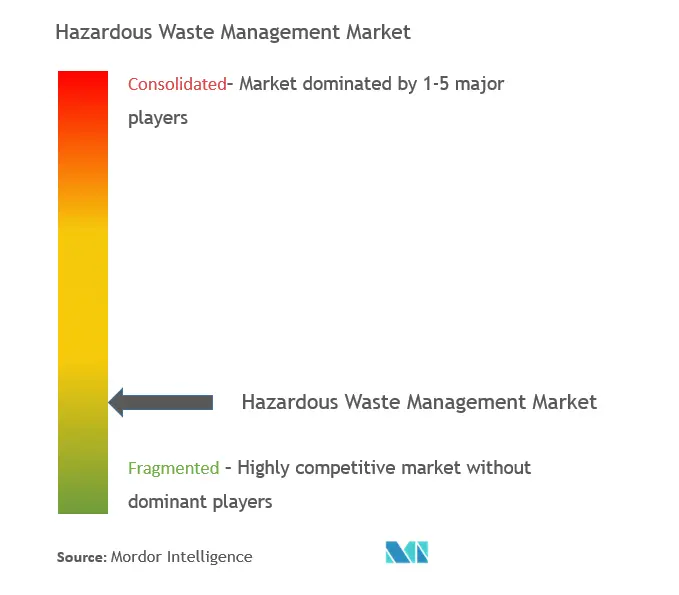
Hazardous Waste Management Market News
April 2024: China Everbright Environment Group Limited, known as Everbright Environment, celebrated the successful construction of its Hue Waste-to-Energy Project in Thua Thien Hue Province, Vietnam. The event was graced by the presence of Vietnamese Prime Minister Pham Minh Chinh.
February 2024: WM announced plans to expand its footprint by establishing three new recycling facilities across North America. Additionally, the company plans to finalize automation enhancements at 10 of its existing sites. These upgrades are projected to boost WM's recycling capacity by an impressive 1 million metric tons annually, a goal slated for achievement by 2026.
Hazardous Waste Management Market Report - Table of Contents
1. INTRODUCTION
- 1.1 Study Deliverables
- 1.2 Study Assumptions
- 1.3 Scope of the Study
2. RESEARCH METHODOLOGY
3. EXECUTIVE SUMMARY
4. MARKET INSIGHTS AND DYNAMICS
- 4.1 Market Overview
-
4.2 Market Drivers
- 4.2.1 Stringent Global Environmental Regulations Drive Demand for Compliant Hazardous Waste Management and Disposal Solutions
- 4.2.2 Increased Industrial Activities and Urbanization Driving up Hazardous Waste Production, Fueling Demand for Waste Management Services
- 4.2.3 Innovations in Waste Treatment Technologies, such as Advanced Recycling and Waste-to-Energy Processes, Enhance Efficiency and Reduce Environmental Impact
-
4.3 Market Restraints
- 4.3.1 Industries Under Economic Pressure Often Struggle to Balance Cost-efficient Waste Management
- 4.3.2 Handling Hazardous Materials Risks Human Health and the Environment, Requiring Strict Safety Protocols and Emergency Response Plans
-
4.4 Market Opportunities
- 4.4.1 Industrialization and Urbanization in Emerging Markets are Driving Growth in Hazardous Waste Management Services
- 4.4.2 Advancements in Waste Treatment Technologies Create Opportunities for Companies Offering Efficient and Sustainable Solutions
- 4.4.3 Strategic Collaborations can Enhance Knowledge Sharing and Technology Investments
- 4.5 Value Chain/Supply Chain Analysis
-
4.6 Porter's Five Forces Analysis
- 4.6.1 Threat of New Entrants
- 4.6.2 Bargaining Power of Buyers/Consumers
- 4.6.3 Bargaining Power of Suppliers
- 4.6.4 Threat of Substitute Products
- 4.6.5 Intensity of Competitive Rivalry
5. MARKET SEGMENTATION
-
5.1 By Type
- 5.1.1 Solid
- 5.1.2 Liquid
- 5.1.3 Sludge
-
5.2 By Waste
- 5.2.1 Chemicals
- 5.2.2 Biomedical
- 5.2.3 Radioactive
- 5.2.4 Other Waste (Corrosive, Flammable, etc.)
-
5.3 Geography
- 5.3.1 North America
- 5.3.1.1 United States
- 5.3.1.2 Canada
- 5.3.2 Europe
- 5.3.2.1 Germany
- 5.3.2.2 United Kingdom
- 5.3.2.3 France
- 5.3.2.4 Russia
- 5.3.2.5 Spain
- 5.3.2.6 Rest of Europe
- 5.3.3 Asia-Pacific
- 5.3.3.1 India
- 5.3.3.2 China
- 5.3.3.3 Japan
- 5.3.3.4 Rest of Asia-Pacific
- 5.3.4 Middle East and Africa
- 5.3.4.1 United Arab Emirates
- 5.3.4.2 Saudi Arabia
- 5.3.4.3 Rest of Middle East
- 5.3.5 South America
- 5.3.5.1 Brazil
- 5.3.5.2 Argentina
- 5.3.5.3 Rest of South America
6. COMPETITIVE LANDSCAPE
- 6.1 Overview (Market Concentration & Major Players)
-
6.2 Company Profiles
- 6.2.1 Suez
- 6.2.2 Valicor
- 6.2.3 Veolia
- 6.2.4 Waste Connections
- 6.2.5 Waste Management
- 6.2.6 Republic Services
- 6.2.7 Biffa
- 6.2.8 Clean Harbors
- 6.2.9 Covanta Holding
- 6.2.10 Daiseki
- 6.2.11 Hitachi Zosen
- 6.2.12 Remondis SE & Co. Kg
- 6.2.13 Urbaser
- 6.2.14 Biomedical Solutions
- *List Not Exhaustive
- 6.3 Other Companies
7. FUTURE OF THE MARKET
8. APPENDIX
- 8.1 GDP Distribution by Activity
- 8.2 Imports and Exports
Hazardous Waste Management Industry Segmentation
The hazardous waste management industry involves handling waste materials that pose significant risks to human health and the environment. This includes collecting, treating, disposing of, and recycling materials deemed hazardous, often due to their toxicity, flammability, corrosiveness, reactivity, or radioactivity.
The hazardous waste management market is segmented by type (solid, liquid, and sludge), waste (chemicals, biomedical, radioactive, and other waste (corrosive, flammable, etc.)), and geography (North America, Europe, Asia-Pacific, Middle East and Africa, and South America). The report offers market sizes and forecasts in value (USD) for all the above segments.
| By Type | Solid | |
| Liquid | ||
| Sludge | ||
| By Waste | Chemicals | |
| Biomedical | ||
| Radioactive | ||
| Other Waste (Corrosive, Flammable, etc.) | ||
| Geography | North America | United States |
| Canada | ||
| Geography | Europe | Germany |
| United Kingdom | ||
| France | ||
| Russia | ||
| Spain | ||
| Rest of Europe | ||
| Geography | Asia-Pacific | India |
| China | ||
| Japan | ||
| Rest of Asia-Pacific | ||
| Geography | Middle East and Africa | United Arab Emirates |
| Saudi Arabia | ||
| Rest of Middle East | ||
| Geography | South America | Brazil |
| Argentina | ||
| Rest of South America |
Hazardous Waste Management Market Research FAQs
How big is the Hazardous Waste Management Market?
The Hazardous Waste Management Market size is expected to reach USD 38.77 billion in 2024 and grow at a CAGR of 3.74% to reach USD 46.57 billion by 2029.
What is the current Hazardous Waste Management Market size?
In 2024, the Hazardous Waste Management Market size is expected to reach USD 38.77 billion.
Who are the key players in Hazardous Waste Management Market?
Waste Management, Veolia, Covanta Holding, Clean Harbors and Biffa are the major companies operating in the Hazardous Waste Management Market.
Which is the fastest growing region in Hazardous Waste Management Market?
North America is estimated to grow at the highest CAGR over the forecast period (2024-2029).
Which region has the biggest share in Hazardous Waste Management Market?
In 2024, the Asia Pacific accounts for the largest market share in Hazardous Waste Management Market.
What years does this Hazardous Waste Management Market cover, and what was the market size in 2023?
In 2023, the Hazardous Waste Management Market size was estimated at USD 37.32 billion. The report covers the Hazardous Waste Management Market historical market size for years: 2020, 2021, 2022 and 2023. The report also forecasts the Hazardous Waste Management Market size for years: 2024, 2025, 2026, 2027, 2028 and 2029.
Hazardous Waste Management Industry Report
Statistics for the 2024 Hazardous Waste Management market share, size and revenue growth rate, created by Mordor Intelligence™ Industry Reports. Hazardous Waste Management analysis includes a market forecast outlook for 2024 to (2024to2029 and historical overview. Get a sample of this industry analysis as a free report PDF download.



